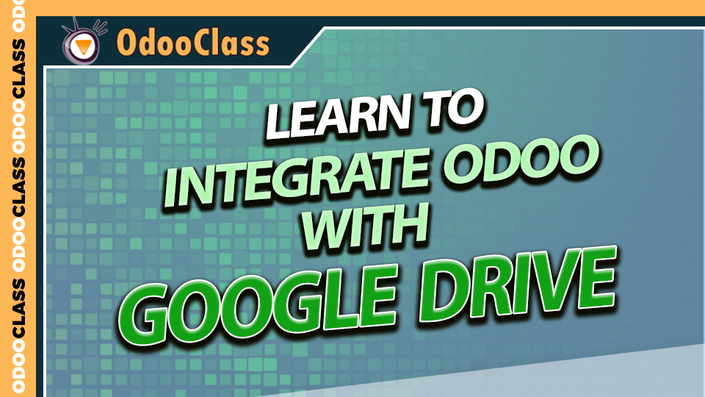
Learn to Integrate Odoo with Google Drive
Explore an Odoo module that uses Google Drive to centralize your document management and simplify backups
Now there are great new options in document management. Here we explore an Odoo module that allows you to use Google Drive to centralize your document management to simplify backups, security, and accessibility.
Learn how you can easily tie Google Drive to Odoo models
Configuring Odoo to talk to Google Drive
Finding solutions to adding many additional fields to ERP systems
Questions about Google Drive integration
What is the big deal about Google Drive integration?
One of the great advantages of Google Drive integration with Odoo is that nearly every business has documents and forms that sit somewhat outside their ERP system. One strategy of course is to try and add lots of extra custom models, fields, and customization into Odoo to account for a lot of industry specific data. Google Drive integration allows you to pursue an alternative strategy. Maintain custom process information and ancillary data inside Google Drive documents.
So how exactly does that work?
Once you have configured Odoo to talk with Google Drive, you can create templates that are automatically attached to any model you choose in Odoo. For example, maybe you have a complex production process like for Silkscreen printing. You need to collect a lot of variables regarding ink combinations, screens, meshes, press requirements, art approvals... the list gets long. Naturally companies already have documents and processes to collect and move this information through production.
So instead of trying to push all that information into an ERP system, you create a spreadsheet template in Google Drive. It has all the placeholders to collect and organize all that complex information. Whenever you go to that production order, you can now pull up that sheet and see all the details. Without customizing Odoo you have integrated and tied a lot of information directly to the production order that will facilitate communication and build on the strengths of the existing workflow.
Odoo creates the documents automatically from your templates
The beautify of this integration is that Odoo will automatically name, store, and associate any template you choose with any model you choose in Odoo. The above example is only one. Think real-estate sales. There are a great deal of information that goes into selling a property. Square feet, number of rooms, acres, design, location.... the list of models and fields you would need to add to Odoo to create a custom real-estate application is quite daunting and would be expensive to develop and implement. However with Google Drive integration you can attach existing templates and forms and attach them to products within Odoo. Now instead of massive customization you can add a few critical fields to Odoo, perhaps like square footage, number of rooms. This would be for searching and easy categorization.
Now imagine instead of adding dozens of fields to Odoo to collect all that would be required to describe the property and that would likely grow in scope and change... you create a template on Google Drive for that property. Then when you create a product in Odoo you can tell Odoo to automatically create a copy of that template, name it according to your specifications and even brings it up automatically for you to collect all the little details you need to on that property. There you attach all the pictures and dozens of little details about the property.
The document then is tied directly to the product record and available anytime you pull up the product, just pull up the Google document with the details formatted in any way you wish. Now instead of spending months to develop something customized it's possible to get a workflow going fast. If you change the template, all new documents from that point on will have the new template.
Known limitations of Google drive integration with Odoo
While this solution is very promising many of the really great abilities are still around the corner. At this time there is no 'mail merge' capabilities built into the Google documents you create. So there is no way to easily populate fields from the models in Odoo and inject them into placeholders within Google documents. There are some workarounds and there is always a way to make it happen but at this point that functionality is not built into the Odoo to Google Drive integration.
Your Instructor

Greg Moss started working with personal computers at 12 years old. At age 15, he wrote his first paid business application, a loan management application for First American Acceptance Corporation. A few months later Greg developed a statistical application to process surveys for John A Logan College. Now more than 30 years later, Greg has produced hundreds of commercial applications and training courses, and has been involved in numerous enterprise application projects.
In addition to completing degrees in Business Administration and Information Systems Design, Greg is a Certified Information Systems Auditor, a Six Sigma Black Belt, and holds an Information Assurance Certification from Carnegie Mellon University. In addition to his successful consulting practice, Greg has worked in positions as a Chief Information Officer (CIO), Chief Executive Officer (CEO), and excels in delivering technology-enabled growth to companies. He is an experienced digital marketer and focuses on real-world results and solutions.
Greg is the founder of First Class Ventures, LLC and OdooClass.com. Over the past 8 years Greg has produced over 200 video courses covering business application development and game design.
Greg is the author of Working with Odoo, Working with Odoo 10, Working with Odoo 11, Working with Odoo 12, and Learn Odoo.

